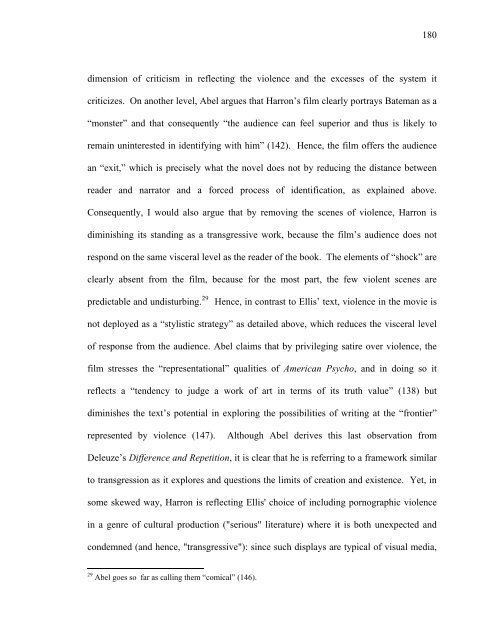Untitled - Sexey's School Moodle
Untitled - Sexey's School Moodle
Untitled - Sexey's School Moodle
You also want an ePaper? Increase the reach of your titles
YUMPU automatically turns print PDFs into web optimized ePapers that Google loves.
dimension of criticism in reflecting the violence and the excesses of the system it<br />
criticizes. On another level, Abel argues that Harron’s film clearly portrays Bateman as a<br />
“monster” and that consequently “the audience can feel superior and thus is likely to<br />
remain uninterested in identifying with him” (142). Hence, the film offers the audience<br />
an “exit,” which is precisely what the novel does not by reducing the distance between<br />
reader and narrator and a forced process of identification, as explained above.<br />
Consequently, I would also argue that by removing the scenes of violence, Harron is<br />
diminishing its standing as a transgressive work, because the film’s audience does not<br />
respond on the same visceral level as the reader of the book. The elements of “shock” are<br />
clearly absent from the film, because for the most part, the few violent scenes are<br />
predictable and undisturbing. 29 Hence, in contrast to Ellis’ text, violence in the movie is<br />
not deployed as a “stylistic strategy” as detailed above, which reduces the visceral level<br />
of response from the audience. Abel claims that by privileging satire over violence, the<br />
film stresses the “representational” qualities of American Psycho, and in doing so it<br />
reflects a “tendency to judge a work of art in terms of its truth value” (138) but<br />
diminishes the text’s potential in exploring the possibilities of writing at the “frontier”<br />
represented by violence (147). Although Abel derives this last observation from<br />
Deleuze’s Difference and Repetition, it is clear that he is referring to a framework similar<br />
to transgression as it explores and questions the limits of creation and existence. Yet, in<br />
some skewed way, Harron is reflecting Ellis' choice of including pornographic violence<br />
in a genre of cultural production ("serious" literature) where it is both unexpected and<br />
condemned (and hence, "transgressive"): since such displays are typical of visual media,<br />
29 Abel goes so far as calling them “comical” (146).<br />
180



